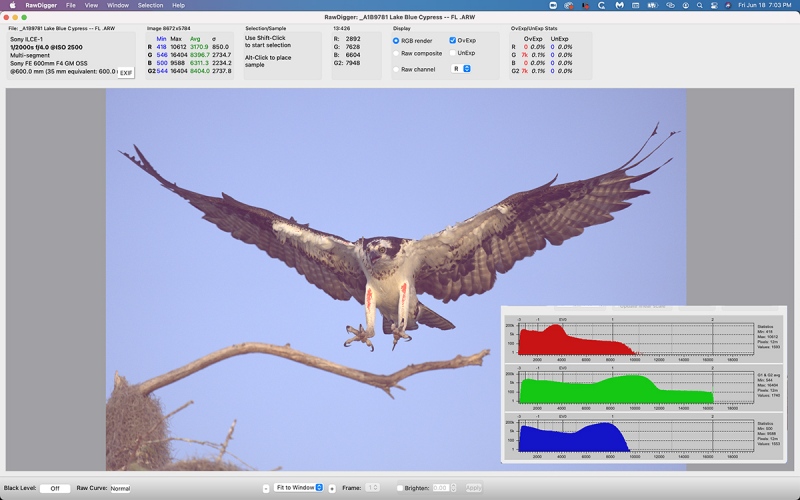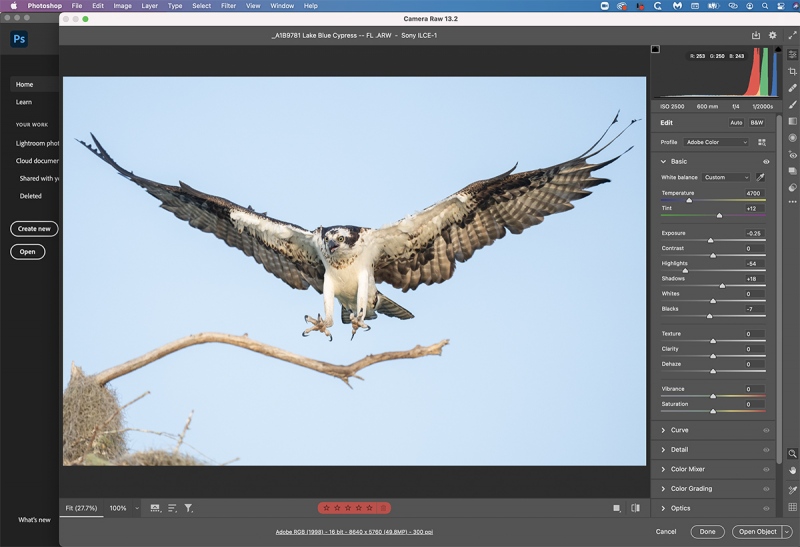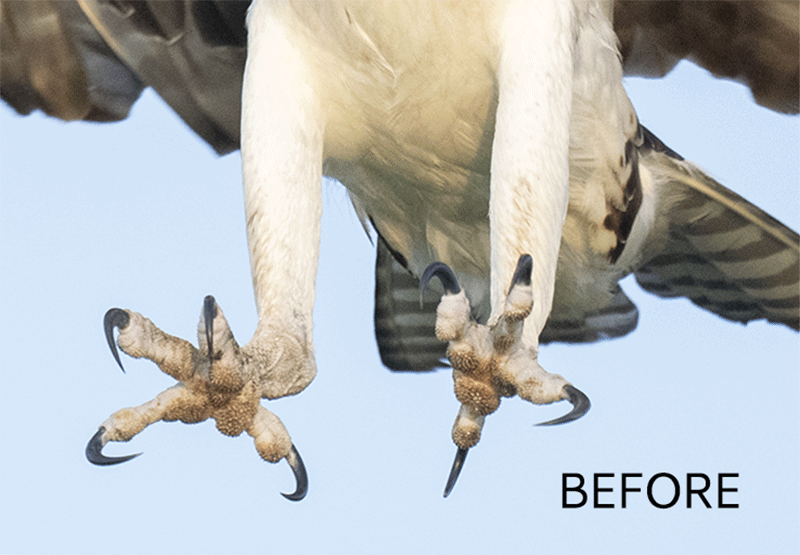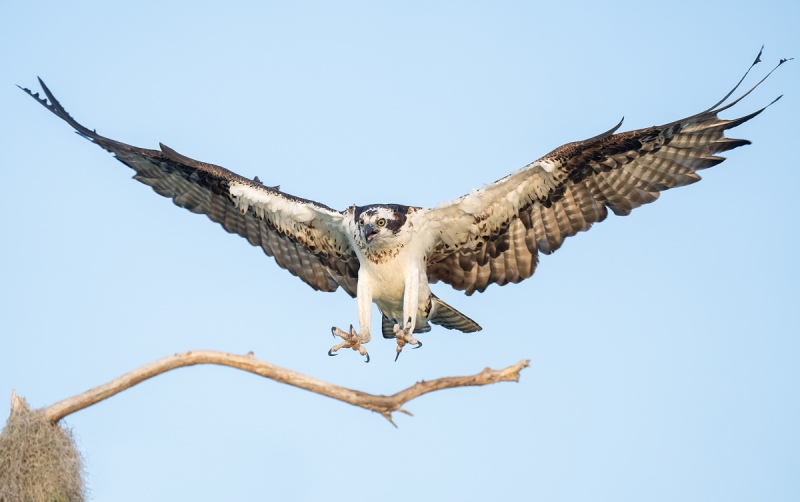What’ Up?
I headed down to the lake yesterday not expecting to do many birds. I wound up sitting in the wet grass for almost an hour with the latest crane family at the end of Palmetto. I can no longer call the two young “chicks” as they are more than half as tall as the adults.
When done with the colts, I went to check on the remaining Black-necked Stilt nest, the beautiful nest with two eggs. As we have had some heavy rains for the past week, the water level was up about six inches. Not good. The nest was flooded and both eggs were gone. The birds, however, were still hanging around. And there was still another pair just to the left of the pair. If they had a nest, it is very doubtful that it is still there. As noted earlier, the breeding success of this species in the shallows of fresh water lakes in Central Florida is precarious at best because of predation and fluctuating water levels …
I think that Steve Elkins may have a Canon R5 or two in stock, and as of yesterday, there was no waiting list for the Sony Alpha a1! Either way you go, be sure to use the BIRDSASART code at checkout to save 3% and enjoy free second-day air Fed-Ex. And the same goes for lenses and for accessories.
Today is Saturday 19 June 2021. The forecast is the same as yesterday’s: early sun followed by clouds. They were wrong both days. When I peeked out the back door at 6:30am yesterday and today, it was totally cloudy. There is less wind today than there was on Friday. I will head down to the lake at about 7:15am to see what I see. Wherever you are, and whatever you are doing, I hope that you too have a great day.
This blog post took more than two hours to prepare and makes 175 consecutive days with a new one. Please remember that if an item — a Delkin flash card, or a tripod head — for example, that is available from B&H and/or Bedfords and is also available in the BAA Online Store, it would be great if you opt to purchase from us. We will match any price. Please remember also to use my B&H affiliate links or to save 3% at Bedfords by using the BIRDSASART discount code at checkout. Doing either often earns you free guides and/or discounts. And doing so always earns my great appreciation.
Levered-Clamp FlexShooters in Stock!
We have just three Levered-clamp Flex-shooter Minis left in stock. They are available in the US only from BAA.
Folks with a big lens should, of course, be working with the Levered-clamp Flex-shooter Pro. This new head on just about any decent tripod like the Induro GIT 304L or the Induro 204L (for travel), is dead-solid-perfect for those whose intermediate telephoto or telephoto zoom lenses are their workhorse lenses for bird and nature photography, for all macro lenses with a tripod collar, and for wide angle lenses with a Wimberley P-5 Plate on the camera body. The levered-clamp is super-fast and secure. Though it weighs only 1lb., 2.4 ozs, this elegantly manufactured head is rock-solid. It takes only seconds to level all FlexShooter heads for smooth, square-to-the-world panning, and these innovative and patented spring-counterbalanced double ballheads will completely eliminate ballhead-flop.
We have lots of Levered-clamp Flex-shooter Pro heads in stock. B&H does not even carry them! I use and rely on mine most ever day that I am out there.
New Listings
Nikon AF-S 80-400mm/4.5-5.6G ED VR Lens with Extra
Paul Sher is offering a Nikon AF-S 80-400mm/4.5-5.6G ED VR in like new condition for $1396.95. The sale includes a Wimberley P-10 plate (a $52.00 value), the front and rear lens caps, the lens case, the original Nikon box, and insured ground shipping via major courier to lower-48 US addresses. Your item will not ship until your check clears unless other arrangements are made.
Please contact Paul Sher via e-mail or by phone at 1-503-248-9870 (Pacific time zone).
I owned and loved this super-sharp and very versatile lens when I shot Nikon. It was my go-to lens on my bucket-list Emperor Penguin trip to Snow Hill Island, Antartica. It complements either the 500 PF or the 600 f/4 VR lenses perfectly. As it sells new for $2,296.95, you can save a very handsome $900.00 on Paul’s pretty much new lens. artie
Nikon AF-S VR Micro Nikkor 105mm F2.8 G IF-ED Lens
Paul Sher is offering a Nikon AF-S VR Micro Nikkor 105mm F2.8 G IF-ED in like new condition for $496.95. The sale includes the front and rear lens caps, the lens bag, and insured ground shipping via major courier to lower-48 US addresses. Your item will not ship until your check clears unless other arrangements are made.
Please contact Paul Sher via e-mail or by phone at 1-503-248-9870 (Pacific time zone).
This super-sharp macro lens is the longest in the Nikkor line-up. It is a must-own for anyone doing flowers and/or bugs. It sells new for $896.95. Save $400.00 by getting in touch with Paul ASAP. artie
|
|
Image #1:The RawDigger screen capture for the Osprey landing with outstretched talons image |
Oops: Over-exposed Leggings!
It is rare that I over-expose an image to this degree. The pink OvExp warning on the legs are all in the two GREEN channels. In addition, note that the G channel in the adapted histogram is pegged against the Y-axis on our right. Why was I trying so (too?) hard to expose to the right in low light? There were two reasons:
1- To reveal as much underwing detail as possible.
2- To reduce the noise in the dark tones.
Via e-Mail from Geri George
Hi Artie, Thanks for the RawDigger e-Guide. With many of my flower images, DPP 4 shows lots of over-exposure on the petals, but RawDigger shows only a smattering (less than a hundred). They all converted perfectly in DPP 4 simply by pulling down the Highlight slider a bit. RawDigger has some really cool stuff!
Thanks and best, Geri
|
|
RawDigger e-Guide with Two Videos |
The RawDigger e-Guide with Two Videos
by Arthur Morris with Patrick Sparkman
The RawDigger e-Guide was created only for serious photographers who wish to get the absolute most out of their raw files. It is not for the faint-of-heart who are happy to go through life under-exposing every raw file they create.
Patrick and I began work on the guide in July 2020. At first we struggled. We asked questions. We learned about Max-G values. We puzzled as to why the Max G values for different cameras were different. IPT veteran Bart Deamer asked lots of questions that we could not answer. We got help from RawDigger creator Iliah Borg. We learned. In December, Patrick came up with an Adapted Histogram that allows us to evaluate the exposures and raw file brightness for all images created with all digital camera bodies from the last two decades. What we learned prompted three complete beginning to end re-writes.
The point of the guide is to teach you to truly mega-Expose-to-the-Right so that you will minimize noise, maximize image quality, best utilize your camera’s dynamic range, and attain the highest possible level of shadow detail in your RAW files in every situation. In addition, your properly exposed RAW files will contain more tonal information and feature the smoothest possible transitions between tones. And your optimized images will feature rich, accurate color.
We teach you why the GREEN channel is almost always the first to over-expose. We save you money by advising you which version of RawDigger you need. We teach you how to interpret the Max G values for your Canon, Nikon, and SONY camera bodies. It is very likely that the Shock-your-World section will shock you. And lastly — thanks to the technical and practical brilliance of Patrick Sparkman — we teach you a simple way to quickly and easily evaluate your exposures and raw file brightness using an Adapted RawDigger histogram.
The flower video takes you through a session where artie edits a folder of images in Capture One while checking the exposures and Max-G values in RawDigger. The Adapted Histogram video examines a series of recent images with the pink histograms and covers lots of fine points including and especially how to deal with specular highlights. The directions for setting up the Adapted Histogram are in the text.
If we priced this guide based on how much effort we put into it, it would sell it for $999.00. But as this guide will be purchased only by a limited number of serious photographers, we have priced it at $51.00. You can order yours here in the BAA Online Store.
|
|
|
Be sure to click on the screen capture for a better look at the sliders. Image #1A:The Camera Raw screen capture for the Osprey landing with outstretched talons image |
Trying to Save the Toasted Whites During the Raw Conversion
In the RawDigger e-Guide you will learn that when all of the OvExp pixels (14,000 in this case), it is sometimes possible to restore detail during the raw conversion. Be sure to click on the image to see how I changed the sliders toward that end. Note: I experimented by moving the Highlights slider to -100 but even that did not help. Even though there was not a single pixel greater than 254 in the master TIF file, it was obvious that many of the white feathers on the legs were completely without detail. Neither NIK Color EFEX Pro nor a Linear Burn can bring back detail when there is none. In this case, the WHITEs were truly toasted.
|
|
Worth Saving!
This sharp frame, with the Osprey barely fitting into the frame, and the bird’s talons just about to grab the perch, was well worth saving. To repair the over-exposed areas on the leggings, I used a series of small, transformed Quick Masks refined by Regular Layer Masks. I began by grabbing the a section of detailed feathers near the bottom of the bird’s left leg, the one on our right. Then it was rinse and repeat.
|
|
The BIRDS AS ART Current Workflow e-Guide (Digital Basics II).You can order your copy from the BAA Online Store here, by sending a PayPal for $40 here, or by calling Jim or Jennifer weekdays at 863-692-0906 with your credit card in hand. Be sure to specify Digital Basics II. |
The BIRDS AS ART Current Workflow e-Guide (Digital Basics II)
The clean-up techniques mentioned above and tons more great Photoshop tips and techniques — along with all of my personalized Keyboard Shortcuts — are covered in detail in the BIRDS AS ART Current Workflow e-Guide (Digital Basics II), an instructional PDF that is sent via e-mail. Learn more and check out the free excerpt in the blog post here. While the new e-Guide reflects my MacBook Pro/Photo Mechanic/DPP 4/Photoshop workflow, folks using a PC and/or BreezeBrowser will also benefit greatly by studying the material on DB II. Note: folks working on a PC and/or those who do not want to miss anything Photoshop may wish to purchase the original Digital Basics along with DB II while saving $15 by clicking here to buy the DB Bundle.
Folks who learn well by following along rather than by reading can check out the complete collection of MP 4 Photoshop Tutorial Videos by clicking here. Note: all of the videos are now priced at an amazingly low $5.00 each.
You can learn how and why I converted all of my Canon digital RAW files in DPP 4 in the DPP 4 RAW Conversion Guide here. More recently, I became proficient at converting my Nikon RAW (NEF) files in Adobe Camera Raw. About two years ago I began converting my Nikon and Sony RAW files in Capture One Pro 12 and continue to do so today.
To purchase Capture One, please use this link. Then you can learn more about Capture One in the Capture One Pro 12 Simplified MP4 Video here. The next step would be to get a copy of Arash Hazeghi’s “The Nikon Photographers’ Guide to Phase One Capture One Pro e-Guide” in the blog post here.
You can learn advanced Quick Masking and advanced Layer Masking techniques in APTATS I & II. You can save $15 by purchasing the pair.
|
|
|
This image was created on 2 May 2021 on Lake Blue Cypress working from Clemens Van der Werf’s flats boat. I used the hand held Sony FE 600mm f/4 GM OSS lens and The One, the Sony Alpha 1 Mirrorless digital camera. ISO 2500. Exposure determined via Zebras with ISO on the rear dial: 1/2000 sec. at f/4 (wide open) in Manual mode. AWB at 7:17am with a cloud in front of the rising sun. Wide/AF-C was active at the moment of exposure and performed perfectly. Be sure to click on the image to see a larger version. Image #1C: Osprey landing with outstretched talons |
The Optimized Image
Yes, for me, this one was well worth saving. Note also, the neat clean-up job on the moss in the lower left corner and the small pano crop. The image from side-to-side represents the full frame original.
The Key Question
Compared today’s featured Osprey landing image with yesterday’s featured Osprey landing image and then leave a comment that answers this question: Why did I hand hold the much heavier 600mm f/4 GM lens for today’s image? (Note that for yesterday’s featured image I used the lighter, easier-to-hand hold 200-600 G lens …)
Typos
With all blog posts, feel free to e-mail or to leave a comment regarding any typos or errors.




















Artie,
Two things that might help with hot pixels in Camera Raw: (1) rather than turning down just Highlights, try a smaller Highlights adjustment combined with an adjustment to the Whites slider; (2) changing Profile from Adobe Color to Landscape seems to knock 5 points or so off the whites, so 254 might become a more manageable 249. Not sure that works every time or with every image, but I’ve noticed it often just checking for the best looking color. If Landscape makes the color too intense, you can just dial back Saturation.
Beautiful ospreys both today and yesterday.
Thanks on all counts, Cliff. I will give that a try.
with love, artie
Typo. “an image do this degree”. sb. to
Thanks, Jordan.
with love, artie
Howdy Artie
I love todays image over yesterdays image as the landing perch is in the picture, the moss would not have bothered me before cleanup but your eye is a lot different, it is when compared a little distracting but it is good to see the real surroundings.
I believe you held the 600GM because of the light and clouds at the time of the day you gained 4 stops to get more shutter, as you always mention the 200-600 works super on sunny days or i don’t think this would have been as great of a picture.
Not all of us have that option to grab a 600 prime over the 200-600
Always with love b
Hi Bob,
I saved 4 clicks (not stops) of ISO. Had I used the 200-600 (at f/6.3) I would have had to have used ISO 6400 to get the same exposure (or ISO 5000 for the right exposure!)
I understand that not everyone can afford or hand hold the 600 f/4. Heck, I can hand hold the big lens only for sporadic flight photography. And it is important for folks who do own both to know when to use each one.
with love, artie